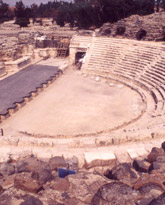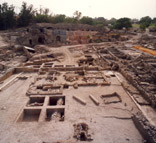Background
The Early Roman Period

The Theather
Gabinius, the proconsul in Syria in the years 57-55 BCE was connected with the establishment and re-founding of Nysa/Scythopolis as evidenced by the city’s coins, which refer to it at first as Gabinis-Nysa. The location of the city was moved once again, this time from the protected mounds in the north to the Nahal Amal basin, at the foot of the tell and the hills surrounding it; this step was a result of the Pax Romana and the feeling of security that was bestowed on the residents of the province. To date the only evidence of the city’s existence at this time has been derived from the coinage and pottery of the period and the architectural remains that were exposed are inadequate in determining a town plan. On the other hand the plan of the city’s civic center from the first half of the 1st century CE was starting to take shape.
The agora (2.20), which served as the focal point of the urban plan, was located in the city’s civic center. The agora included a temenos that contained two temples (2.22, 2.23) in its southeast and a basilica (2.19) in its northeast. At the beginning of the century a theater was built south of the agora. The remains of the two phases of this theater (the second phase dates to the time of Tiberius) were found below the foundations of the later theater that was built on top of it during the reign of Septimius Severus. A 12 m wide street paved with basalt slabs leading from the north to the temple compound was installed to the east of the agora. Evidence revealed in the excavations has established that there was another street that ran along a route close to Palladius Street, which was west of the agora. It also seems that the northwestern entrance to the city from Caesarea was already in use at this time. Remains of a bathhouse were found east of the agora and at the foot of the tell there were the remains of shops and another street. It therefore seems that during the course of the 1st century CE the basis of the urban plan of Nysa/Scythopolis had already taken shape, a plan that during the course of the 2nd century CE was characterized by monumental magnificence.
Even though the sources of the period are vague regarding the history of Nysa/Scythopolis at this time, it seems that it was included amongst the territories granted by Anthony to Cleopatra. Yet the city was not among those that were annexed by Augustus to Herod’s kingdom and therefore continued to be part of the province of Syria. It seems that the establishment of Caesarea as a principal port city and the location of Nysa/Scythopolis on a regional cross-road that linked the coastal cities with Damascus on one hand, and the cities of Transjordan and their extensive commerce ties with Caesarea on the other, imparted the city with greater importance, security and economic prosperity. This was interrupted when the Jews of the city were massacred following the riots in Caesarea in August/September 66 CE (The Jewish War II 458-468), after which a cavalry unit under the command of Neopolitanus was stationed in Scythopolis for its protection. After the siege of Yodefat, the fifteenth legion was sent by Vespasian to rest up near the city, most likely in the legion’s camp at Tel Shalem. The unrest that prevailed in the country in the years preceding the Bar Kokhba uprising, between the years 117-120 CE, brought about an upgrade in the status of Judah, in which Nysa/Scythopolis was now included, to the rank of a consular province. As a result of this, another legion was stationed in the province and its headquarters was established at Kfar Otnay/Legio, on the fringes of the Jezreel Valley, midway between Nysa/Scythopolis and Caesarea.

The Agora
Annexation of the Nabatean kingdom, the establishment of Bosra as the capital of Provincia Arabia and the construction of the Via Nova Triana, which are among the benefits of Trajan’s eastern policies, improved the status of Scythopolis and granted greater importance for its location as a cross-road of main thoroughfares between the east and the coastal ports. Hadrian visited the city in the spring of 130 CE and was received by the governor of the province, Tinius Rufus, as indicated by a number of inscriptions that were found in the temple compound of the agora. The visit constitutes a direct continuation of his predecessor’s regional policy, was manifested in the administrative and military organization of the province and also included among other things improvements to the ramified network of roads in the region. The suppression of the Bar Kokhba revolt and establishment of peace in the province resulted in the construction of a triumphal gate, on behalf of the senate and Roman people, inside the city, most likely in the legion’s camp at Tel Shalem, south of the city.
Nysa/Scythopolis was now on the verge of a period of prosperity during which it reached the height of its development. Even though the beginning of this prosperity is attributed to Hadrian, the fruits of the success were reaped primarily under his successors, Antoninus Pius and Marcus Aurelius. One should also attribute to this period of prosperity the opening of the Gilboa quarries that henceforth were the source for the limestone that was used to build the city’s magnificently designed monumental structures that were erected at this time.